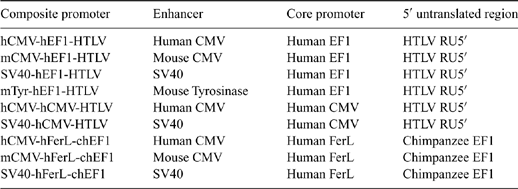231 SELECTION OF UBIQUITOUS AND ENDOTHELIUM-SPECIFIC PROMOTERS FOR EXPRESSING TRANSGENES IN PIG
Y. Chen A and B. Mir AIndiana University, Indianapolis, IN, USA
Reproduction, Fertility and Development 22(1) 273-274 https://doi.org/10.1071/RDv22n1Ab231
Published: 8 December 2009
Abstract
Several promoters of different origins have been used to drive expression of transgenes in pig with variable results. However, there has not been a systemic search to identify the most reliable, ubiquitous, and tissue-specific promoters, such as endothelium-specific promoters, to drive expression of transgenes with high predictability. In this study we tested 9 ubiquitous mammalian promoters, generated by assembling enhancers, minimal promoters, and 5′untranslated region of different origins (Table 1) and 5 endothelial-specific promoters: hFlt-1 (fms-like tyrosine kinase), hICAM-2 (intercellular adhesion molecule-2), andhEndoglin promoters from human; mouse Tie-2 promoter (Schlaeger et al. 1997 PNAS 94, 3058-3063); and pig ICAM-2 promoter (Godwin et al. 2006 Xenotransplantation 13, 514-521). These promoters drive the expression of either GFP or LacZ reporter genes and were electroporated into 9 different pig cell types: endothelium-derived 2A2 and PEDSV15 cells (Seebach et al. 2001 Xenotransplantation 8, 48-61), nasal fibroblasts, kidney epithelial cells, and lung macrophages (ATCC, CRL-2528, 2842, and 2843), pig fetal fibroblasts, liver stem cells, fat-derived stem cells, and immortalized liver endothelial cells (generated in the lab). The expression was graded as week, moderate, or strong depending on the brightness of GFP signal or intensity of LacZ staining. Out of 9 ubiquitous promoters, 7 showed either low expression in all cell types or different levels of expression in some of the cell types. However, 2 promoters, hCMV-hCMV-HTLV and SV40-hCMV-HTLV, showed strong and stable expression across all 9 cell types. Among endothelial-specific promoters, pig ICAM-2 promoter showed moderate and specific expression in all 3 endothelial cell types (strong expression with the enhancer) and no expression in non-endothelial cells. Human EC-specific promoter hFlt-1 showed moderate expression in all 3 endothelial cell types, as well as in some of the non-endothelial cells such as liver stem cells, fat-derived stem cells, and lung macrophages. The other endothelial-specific human and mouse promoters did not show any expression in both endothelial and non-endothelial cells. In summary, we identified hCMV-hCMV-HTLV and SV40-hCMV-HTLV as 2 ubiquitous promoters and pICAM2 as an endothelial-specific promoter for expression of transgenes in pig. In the future, we will test these 3 promoters for in vivo expression studies.

|


